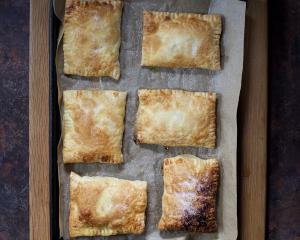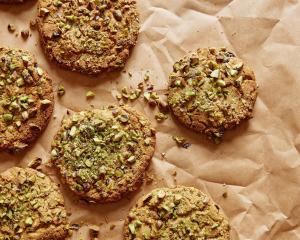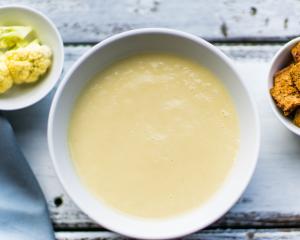
He explains how this book follows Plenty and Plenty More, becoming "P3", and echoes the three ways those flavour bombs can be created.
He says the "three Ps - process, pairing and produce" are the key concepts behind "what makes certain vegetable dishes taste so good".
First there is process, for example with celeriac in the initial cooking phase when something "magical" happens as the water evaporates and the flesh turns from white to brown and the celeriac becomes sweeter and richer.

Pairing is the combination of ingredients in the four most important pairings: acidity, heat, fat and sweetness. Take the addition of sour-sweet tamarind and lime juice to fresh asparagus:
"All these layers and iterations of sour come together in a single harmony which heightens and alters the taste of raw asparagus in a way that really opens your eyes to the vegetables."
The third is produce. While most vegetables are not as good at imparting flavour as meat or fish because of their high water content and low levels of fat and protein, some such as mushrooms are brilliant at it as they are "bursting with umami".
Using all three principles to create a dish is what makes it "exquisite", he says.
The book is divided into three sections based on these processes, each with an introduction explaining the concepts.
Taking on the challenge to ramp up flavour in vegetables, he has used every possible tool available, including using ingredients such as anchovies, fish sauce and Parmesan, which are not often used with vegetables.
Ottolenghi likes to take a "flexitarian" approach to cooking and eating, so many of his recipes are easily "veganised".
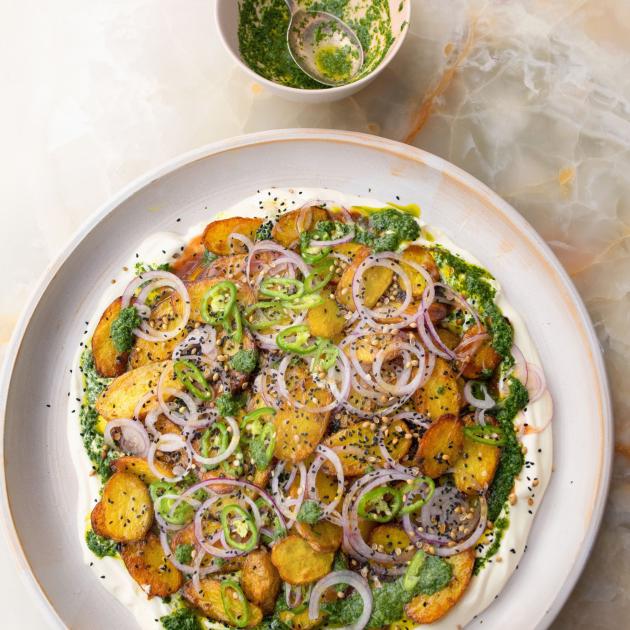
Chaat masala potatoes with yoghurt and tamarind
This dish is inspired by aloo chaat, an Indian street food that has many regional variations, all of which are not for the faint-hearted because they are loaded with sweet and sour and a fair bit of crunch.
This is a slightly tamer version, though still pretty "noisy", both in flavour and in looks. It’s absolutely perfect for a weekend lunch, alongside other vegetables, such as aubergine with herbs and crispy garlic, or radish and cucumber salad with chipotle peanuts. You can also serve it as a side with roasted lamb or chicken.
Chaat masala is the slightly tangy spice mix that gives this dish its distinctive flavour. It gets its sharpness from amchoor, dried mango powder, which is used widely in Indian cooking as a souring agent. You’d recognise the flavour from samosas and pakoras, where it is often used.
Both the coriander chutney and the tamarind sauce are both great condiments to have on hand to brighten up sandwiches and wraps, to spoon over eggs, or to serve alongside tofu or fish. Double or triple them, if you like - the coriander chutney will keep in the fridge for up to a week and the tamarind sauce for up to 2 weeks.
Serves 4 as a side
750g baby new potatoes, cut lengthways
into 1cm-thick slices
2 Tbsp olive oil
1 tsp chaat masala
½ tsp ground turmeric
250g Greek-style yoghurt
½ small red onion, peeled and thinly
sliced into rounds on a mandolin, if you
have one, or by hand
1 green chilli, thinly sliced into rounds
1½ tsp coriander seeds, toasted
1½ tsp nigella seeds, toasted
salt
Coriander chutney
30g fresh coriander
1 green chilli, deseeded and roughly
chopped
1 Tbsp lime juice
60ml olive oil
Sweet tamarind dressing
1½ Tbsp shop-bought tamarind paste, or
double if you’re extracting it yourself
from pulp
1½ tsp caster sugar
¼ tsp chaat masala
Method
1. Heat the oven to 220degC fan.
2. Put the potatoes and 2 teaspoons of salt into a medium saucepan and top with enough cold water to cover by about 4cm. Place on a medium-high heat, bring to the boil, then simmer for 6 minutes, or until they’re almost cooked through but still retain a bite. Drain through a sieve and pat dry, then transfer to a large parchment-lined baking tray and toss with the oil, chaat masala, turmeric, one-third of a teaspoon of salt and a good grind of pepper. Roast, stirring once or twice, for 35 minutes, or until deeply golden.
3. Meanwhile, make the coriander chutney. Put all the ingredients and one-quarter of a teaspoon of salt into the small bowl of a food processor and blitz until smooth. Set aside until needed.
4. For the tamarind dressing, whisk together all the ingredients in a small bowl with 1 and a-half teaspoons of water and set aside.
5. Spread the yoghurt out on a large round serving platter. Top with the coriander chutney, swirling it through without completely incorporating. Drizzle with half the tamarind dressing, and top with the potatoes, onion and chilli. Drizzle over the remaining tamarind, then sprinkle over the seeds and serve.

This lasagne involves one of two epic ragu recipes in this book - the other is the ultimate tray-bake ragu, - which, we believe, give any meat ragu a terrifically good run for its money.
This particular ragu pays homage to penne all’Aconese, the first dish that Ixta fell madly in love with. It’s served at Ristorante Pizzeria Acone, a community-run restaurant in the Tuscan village of Acone, perched at the top of the mountain on which she spent her formative childhood years. The recipe is a closely guarded secret, but the complex, earthy and deeply umami flavour of dried porcini mushrooms is impossible to miss. This is our meatless take on that mythical sauce.
The ragu can easily be made vegan if you lose the cream. It can also be made ahead and refrigerated, ready to be served with pasta or polenta, saving yourself the trouble of constructing the lasagne if you’re short on time.
Reduce the black pepper and lose the chilli for a child-friendly version. If you want to get ahead, the lasagne can be assembled, refrigerated and then baked the next day (once it’s come back up to room temperature).
Ingredients
750g chestnut mushrooms, halved
500g oyster mushrooms
135ml olive oil, plus extra for greasing
60g dried porcini mushrooms
30g dried wild mushrooms
2 dried red chillies, roughly chopped
(deseeded for less heat)
500ml hot vegetable stock
1 onion, peeled and quartered
5 garlic cloves, roughly chopped
1 carrot, peeled and quartered (90g)
2–3 plum tomatoes, quartered (200g)
75g tomato paste
130ml double cream
60g pecorino Romano, finely grated
60g Parmesan, finely grated
5g basil leaves, finely chopped
10g parsley leaves, finely chopped, plus
an extra tsp to serve
250g dried lasagne sheets (that’s about
14 sheets)
salt and black pepper
Method
1. Heat the oven to 230degC fan.
2. Put the chestnut and oyster mushrooms into the large bowl of a food processor in three or four batches and pulse each batch until finely chopped (or finely chop everything by hand). Toss the chopped mushrooms in a large bowl with 3 tablespoons of oil and 1 teaspoon of salt and spread out on a large, 40cm x 35cm parchment-lined, rimmed baking tray. Bake for 30 minutes near the top of the oven, stirring three times throughout, until the mushrooms are golden-brown; they will have reduced in volume significantly. Set aside. Reduce the oven temperature to 200degC fan.
3. Meanwhile, combine the dried mushrooms, chillies and hot stock in a large bowl and set aside to soak for half an hour. Strain the liquid into another bowl, squeezing as much liquid from the mushrooms as possible to get about 340ml: if you have any less, top up with water. Very roughly chop the rehydrated mushrooms (you want some chunks) and finely chop the chillies. Set the stock and mushrooms aside separately.
4. Put the onion, garlic and carrot into the food processor and pulse until finely chopped (or finely chop everything by hand). Heat 60ml of oil in a large saute pan or pot on a medium-high heat. Once hot, add the onion mixture and fry for 8 minutes, stirring occasionally, until soft and golden. Pulse the tomatoes in the food processor until finely chopped (or finely chop by hand), then add to the pan along with the tomato paste, 1 and a-half teaspoons of salt and 1 and three-quarter teaspoons of freshly cracked black pepper. Cook for 7 minutes, stirring occasionally. Add the rehydrated mushrooms and chillies and the roasted mushrooms and cook for 9 minutes, resisting the urge to stir: you want the mushrooms to be slightly crisp and browned on the bottom. Stir in the reserved stock and 800ml of water and, once simmering, reduce the heat to medium and cook for about 25 minutes, stirring occasionally, until you get the consistency of a ragu. Stir in 100ml of the cream and simmer for another 2 minutes, then remove from the heat.
5. Combine both cheeses and both herbs in a small bowl. To assemble the lasagne, spread one-fifth of the sauce in the bottom of a round 28cm baking dish (or a 30cm x 20cm rectangular dish), then top with a fifth of the cheese mixture, followed by a layer of lasagne sheets, broken to fit where necessary. Repeat these layers three more times in that order, and finish with a final layer of sauce and cheese: that’s five layers of sauce and cheese and four layers of pasta.
6. Drizzle over 1 tablespoon of cream and 1 tablespoon of oil, then cover with foil and bake for 15 minutes. Remove the foil, increase the temperature to 220degC fan and bake for another 12 minutes, turning the dish round halfway. Turn the oven to grill for a final 2 minutes, until the edges are brown and crisp. Set aside to cool for 5 or so minutes, then drizzle over the remaining tablespoon of cream and oil. Sprinkle over the remaining parsley, finish with a good grind of pepper and serve.
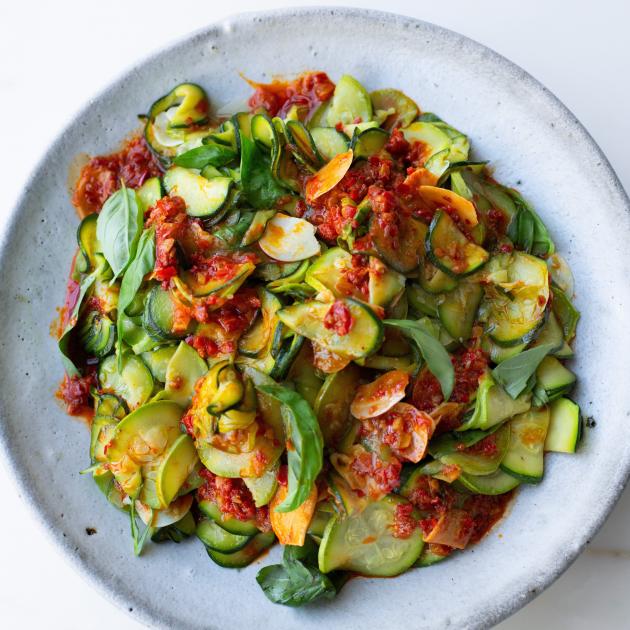
Super-soft courgettes with harissa and lemon
Courgettes aren’t strictly speaking controversial, but they do tend to get a pretty lukewarm reaction from many, including, regrettably, two of our test kitchen colleagues. The reason for this is probably courgettes’ high water content, which tends to make them, well, watery. There are plenty of ways to combat this - frying and grilling are two examples - but we actually use it to our advantage here, cooking the courgettes slowly in their own juices, making them fantastically soft and enhancing their flavour by a long soak with fried garlic. (And in the process, we also managed to win over our two courgette-iffy colleagues, we’re happy to announce.)
The courgettes are very good hot, but are even better after 15 minutes or so, or even at room temperature, once the flavours have had a chance to get to know each other. Make them a day in advance, if you want to get ahead; just hold off on adding the basil until you’re ready to serve.
Serves 4 as a side or mezze
85ml olive oil
6 garlic cloves, finely sliced
1 Tbsp rose harissa (adjust according
to the brand you are using, available
at specialty food stores and online)
1 red chilli, finely chopped
½ preserved lemon, finely chopped,
discarding any pips (10g)
1½ Tbsp lemon juice
1kg courgettes, finely sliced
10g basil leaves, roughly torn
salt
Method
1. Place a large, non-stick saute pan on a medium-high heat with the oil and garlic. Gently fry for 4 minutes, stirring often, until soft, golden and aromatic. You don’t want the garlic to become at all browned or crispy, so turn the heat down if necessary. Remove 3 tablespoons of oil, along with half the garlic, and transfer to a small bowl with the harissa, chilli, preserved lemon and lemon juice. Stir together and set aside.
2. Return the pan to a high heat and add the courgettes and 1 and a-quarter teaspoons of salt. Cook for 18 minutes, stirring often, until the courgettes are very soft, but are still mostly holding their shape (you don’t want the courgettes to brown, so turn the heat down if necessary). Stir through half the basil and transfer to a platter. Spoon the harissa mixture over the courgettes. Leave to sit for 15 minutes, then sprinkle with a pinch of salt and finish with the remaining basil.

